The worst rioting in decades began in Dublin on the evening of Thursday 23 November 2023.
A year later, the impact of what happened is still being felt across the city, as Mark Coughlan and Kate McDonald report.
As dawn broke on Friday 24 November 2023, repair crews were out on Dublin’s O’Connell Street trying to piece the Luas line back together.
"The shopkeepers were coming out to them, offering them tea and coffee, sharing their stories about what they had seen, and what they thought," recalls David Rooney, Director of Operations at Transdev, the company that operates the Luas rail system.
The street itself had only been declared safe for workers by An Garda Síochána and Dublin Fire Brigade a few hours previously, after the worst night of rioting in decades in the city.
Already, staff from Dublin City Council, Transdev, the emergency services, and numerous contractors, were working.
"It was a real sense of ourselves pulling together to get the job done, but also a sense of Dublin pulling together," said Mr Rooney.
The previous evening, the rioting had begun at the junction where O’Connell Street meets Parnell Street.
After a horrific stabbing attack on children and their carer just before 2pm, gardaí had established a crime scene cordon on the north edge of the junction. Luas tracks run across it, and a small crowd gathered on them from around 4pm, in front of the cordon.
Read more: Dublin Riots one year on: A school community and city struggle to heal
Initially they blocked one Luas tram from passing, then another.
By 6pm, the crowd had swelled, and anger had grown within it. The crime scene cordon was breached, nearby garda vehicles were attacked, and gardaí seriously assaulted.
By 7pm, parts of the city were spinning out of control. Garda reinforcements had begun arriving in riot gear from across Leinster, to try to restore order in the capital. The entrance to a nearby hostel used by migrants was being smashed in, a tourist hotel’s lobby was being destroyed.
By 8pm, fires were burning all across the city centre, millions of euro worth of damage had been done, and numerous shops were being looted.
Staff from Dublin City Council’s cleaning crews were on the ground as the anger started growing. As the situation began to spiral, Derek Kelly, an executive manager in Dublin City Council who oversees waste management, recalled them to various depots due to concerns for their safety.
The crews watched news updates arrive in on their phones over the course of the night, as the destruction swept across large parts of the city centre.
"If anything, I was trying to keep them in the depots. I was constantly getting calls from the inspectors saying, 'can we go back out? The lads want to get out and get started,'" Mr Kelly told Prime Time in recent days.
"They're predominantly lads from Dublin, inner city lads that work in waste management, so they wanted the city tidy. They didn't want this in their communities, and they were more than willing to get stuck in."
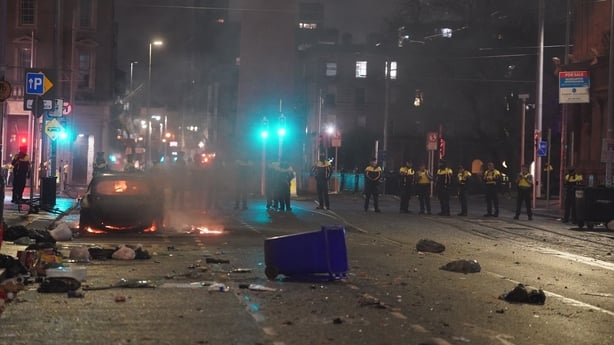
In the midst of all the violence and anger, the tram which was originally blocked by the small crowd at the cordon had been reversed along the Luas track down O’Connell Street.
Several city crisis management teams had been convened. Among the members of a team focused on transport provision was David Rooney of Transdev.
He was in the company's base at the Red Cow, watching high resolution CCTV, when at around 7.30pm someone entered the tram O’Connell Street and set it on fire.
Thankfully, in the hours beforehand, Luas staff had been told to leave the area. Soon, the tram - valued at €5m - was engulfed in flames.
"Our main priority was really get the staff out of harm's way," he told Prime Time. "We have 23 different nationalities who work with us here, and we're conscious of everybody's safety."
"It was a very emotive evening for all of us. I'm a proud Dub... I'm working on the trams here for 20 years now at this stage. It was sad."
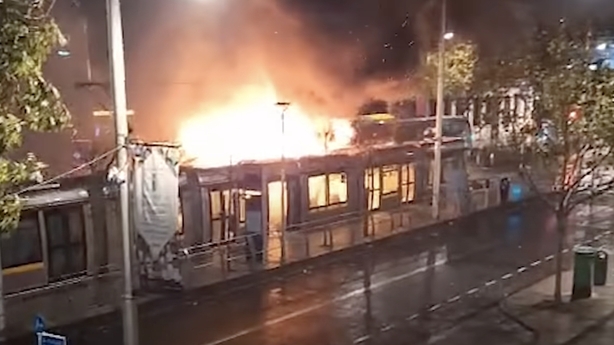
Across the city, it was quickly becoming clear that it was a night that would change Dublin, and its people.
The Music Café on Wellington Quay was one of many businesses targeted. Since then, its management has been taking extra precautions about staffing and staff safety.
Members of the management team did not want their names published, but said the riots have had a psychological as well as financial impact, with several non-Irish staff fearful of coming to work.
"We had to put more of an emphasis on all the opening and closing duties, make sure nobody was on their own and make sure everything was locked up properly," they said.
"We’ve always been wary with our rosters - trying not to have girls on their own and that kind of thing - but that really had to be reinforced."
On the night of the riots, a crowd which left O’Connell Street made its way to Parliament Street. Along the way they passed the cafe - which is on the ground floor of a listed building - and kicked in two huge windows.
"We lost two weeks of business because we had a gaping hole in the building and couldn’t have anybody inside because it was too dangerous," the manager of the cafe said.
"That nearly killed us... we lost whatever reserves we had in the bank at the time. I never built it back up."
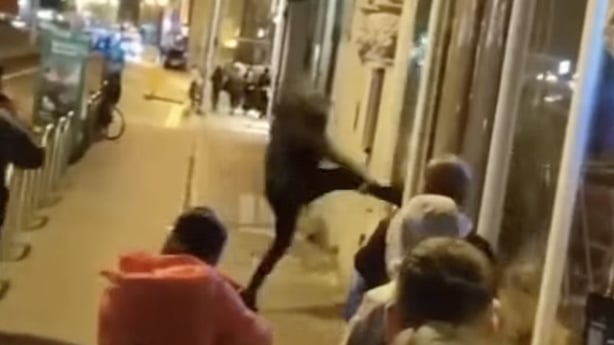
In the aftermath, businesses and people in the city rallied together. Like others, the cafe managers spoke about how Rathmines Glass replaced their windows, charging just the trade cost of materials while waiving their labour costs.
"It was basically half the price it should have been, and if it wasn’t for that, we might have had to shut down," the manager of the cafe said.
They did the same for Bike Stop too, just across the Liffey on Capel Street.
On the night of the riots a small group of mainly young people also smashed the predominantly glass front of the shop before looting and ransacking bikes and equipment.
CCTV captured it all, while in phone footage taken from the street outside members of the group could be heard laughing as they cycled stolen bikes away.
"It was such a bizarre set of circumstances which caused that all to kick off and they, they took it, you know, they took that chance," recalls Cliff Nolan, who owns Bike Stop.
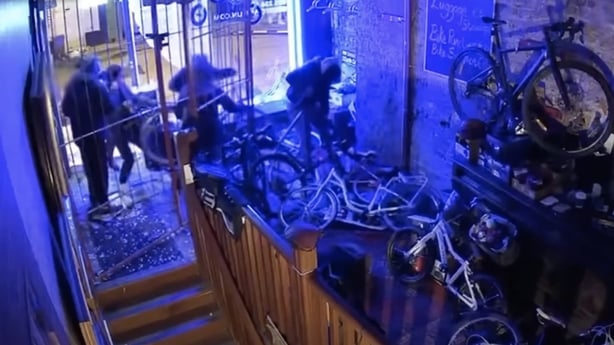
The glass repair work helped him to get back open in the aftermath.
"Town was still very tense. People were acting differently...and business was, well, yeah, well interrupted. You know, things weren't normal," Mr Nolan recalls.
"I was shocked and amazed by the kindness, the generosity around me, and the people, just the neighbourhood and customers, and people I didn't know."
"It was quite moving to feel that there was actually, there's quite a community within the city, you know, in the different streets... well especially here in Capel Street."
Across Dublin, residents, workers and businesspeople feel the city centre has been changed by riots.
Eddie Byrne is a driver trainer for Transdev, and a proud Dub. Early the next morning he was also on the ground on O’Connell Street, as workers tried to fix overhead cables and plan the removal of the Luas tram.
"I felt really embarrassed of the whole thing and ashamed, I did. Like that – that?! - could happen, in our city?"
Watch: A moment-by-moment breakdown of how the riots on 23 November 2023 developed
Paula Kearney, a community worker from the north inner city who works in addiction services, remembers how the violence and hatred displayed made her fear for the safety of her children.
"My own children are people of colour, so I had fear for my own children, I'll be honest with you - going to school or not - when you're seeing such hatred arrive."
She recalls speaking with migrant workers who "were in fear coming into work for a couple of weeks after that, and rightly so."
"You can totally understand that they were scared to come out - people from the community [were] scared to send their children to school for a few weeks after it," she said.
"The majority of the community was shocked at what happened and did not like what was happening. It was horrific to watch the way something so tragic was used to manipulate the community," she said.
The impact of that day was felt differently by different people in the city, Ms Kearney believes.
"I think animosity has increased towards migrant people. Not from everyone, but animosity has increased," she says, "it caused a bit of division, and a bit of mistrust of people who are not Irish."
For others, Ms Kearney says, "one of the worst parts was listening to people stand up and call people from the community thugs and scumbags."
"I'm not condoning what anyone done, not by a long shot," she said, "but there was no understanding of the generational poverty - marginalisation - that this community experiences... how when something like that happens, how it's very easy to rile up a lot of young people to the point that they get involved in riots."
A year on, the impact of that night is still being felt. Some people who spoke to Prime Time for this article said they have seen an uptick in anti-social behaviour among younger children, who are seemingly disinhibited by what happened.
"It just seems to be a lot of kids running around the age of probably from 8-years-old to 12, 13-years-old. They're already drinking... they're just running around the city," one said.
Cliff Nolan of Bike Stop agrees.
"During school breaks and stuff like that, you get gangs of teenagers and they just storm the shop and they just push things around, they damage some stuff."
"They didn't happen before so much, but now it does, it does happen," he said.
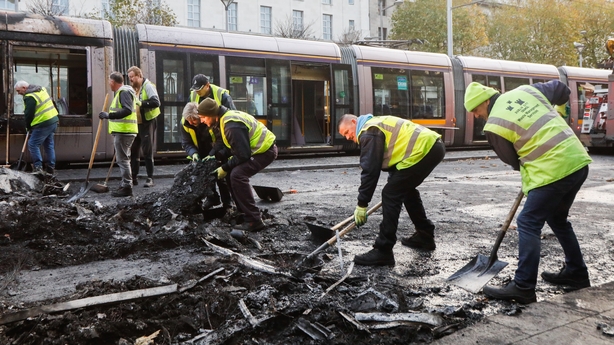
For many, the riots evoke contrasting memories. They recall seeing the worst and the best of the city at once: the destruction, violence and vitriol standing in contrast to the solidarity, community and compassion.
They spoke about locals who attempted to stand up to groups fomenting anger, business owners thanking council workers for their work, individual guards working through the night to get a grip back on the city.
The burned-out Luas tram was removed from O’Connell Street the next afternoon.
Council road maintenance sorted the bridge within hours. Staff from businesses took their own fire extinguishers to what was left of rioters’ barricades. Locals working for the Council’s waste management teams refused to go home.
For Eddie Byrne, "it reminded me of when you get a heavy snowfall."
"People all try to help each other, push your car, you don't have to ask for money to help you. It's that type of togetherness we got."
For others, the memories of the riots linger as a stark reminder of the darkness that overshadowed the city's resilience.

